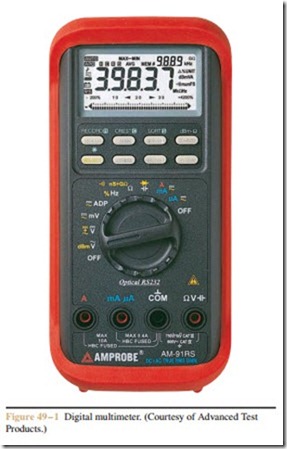It is not a question of if a control circuit will eventually fail, but when will it fail. One of the main jobs of an industrial electrician is to troubleshoot and repair a control circuit when it fails. In order to repair or replace a faulty component, it is first necessary to determine which component is at fault. The three main instruments used by an electrician to troubleshoot a circuit are the voltmeter, ohmmeter, and ammeter. The volt- meter and ohmmeter are generally contained in the same meter (Figure 49 – 1). These meters are called multimeters because they can measure several different electrical quantities. Some electricians prefer to use plunger type voltage testers because they are not susceptible to ghost voltages. High impedance voltmeters often give an indication of some amount of voltage, caused by feedback and induction. Plunger type volt- age testers are low impedance devices and require several milliamperes to operate. The disadvantage of plunger type voltage testers is that they cannot be used to test control systems that operate on low voltage, such as 24 volt systems.
Ammeters are generally clamp-on type (Figure 49 – 2). Both analog and digital meters are in common use. Clamp-on type ammeters have an advantage in that the circuit does not have to be broken to insert the meter in the line.
Safety Precautions
It is often necessary to troubleshoot a circuit with power applied to the circuit. When this is the case, safety should be the first consideration. When de- energizing or energizing a control cabinet or motor control center module, the electrician should be dressed in flame retardant clothing and wearing safety glasses, a face shield, and hard hat. Motor control centers employed throughout industry generally have the ability to release enough energy in an arc-fault situation to kill a person thirty feet away. Another rule that should always be observed
when energizing or de-energizing a circuit is to stand to the side of the control cabinet or module. Do not stand in front of the cabinet door when opening or closing the circuit. A direct short condition can cause the cabinet door to be blown off.
After the cabinet or module door has been opened, the power should be checked with a voltmeter to make certain the power is off. A procedure called check, test, check, should be used to make certain that the power is off:
1. Check the voltmeter on a known source of voltage to make certain the meter is operating properly.
2. Test the circuit voltage to make certain that it is off.
3. Check the voltmeter on a known source of voltage again to make certain that the meter is still working properly.
Related posts:
Incoming search terms:
- safety precautions of troubleshooting and repair
- precautions when troubleshooting integrated circuits
- state 2 precaution to be observe when troubleshooting integrated circuits
- Safety in troubleshooting electronic equipment
- precautions in troubleshooting ics
- safety precautions in troubleshooting ics
- safety precaution in trouble shooting
- safety In Trubleshooting Electronic Equipment
- precautionsfrom troubleshooting
- electrical precautions that needed during trouble shooting
- safety precautions troubleshooting
- state two precaution to observe when troubleshooting intergrated circuit
- Trableshoting precaution
- troubleshooting precautions
- troubleshooting safety precautions
- two precautions observed when troubleshooting ic
- what are electrical precautions that needed during trouble shooting
- What are the precautions of trouble shooting
- precautions to observe when troubleshooting intergrated circuits
- precautions to observe when troubleshooting integrated circuits
- observations and precaution on electric troubleshooting and repair
- precautins taken when troubleshoting integrated circuits
- precaution observed before troubleshooting a electrical equipment
- precaution observed when trouble shooting Intergrated circuits
- precaution of troubleshooti
- precaution on contactor troubleshooting
- precaution that are undertaken in trouble shooting
- precaution when trouble shooting ic
- precaution when troubleshooting an integrated circuit
- precaution when troubleshooting electrical machine
- Precautions and observations on electrical trouble shooting and repairs
- precautions In troubleshooting techniques
- precautions observed when troubleshooting integrated circuits
- precautions of troubleshooting electrical equipment
- precautions on troubleshooting
- precautions taken when troubleshooting integrated circuits
- what are the safety precaution in troubleshooting
